When we think of contemporary art, we generally understand it to be under lock and key, relegated to the inside of a museum, gallery, or within a wholly inaccessible private collection. While public art seeks to disavow the notion that art is merely meant for the few, not all of it is accessible in a cultural respect — even though, by definition, it is accessible to all. Though the long tradition of public art begins way before our contemporary understanding, the emergence and ongoing explosion of this work as a popular cultural currency has transformed the ways that people engage and view media previously seen as elitist.
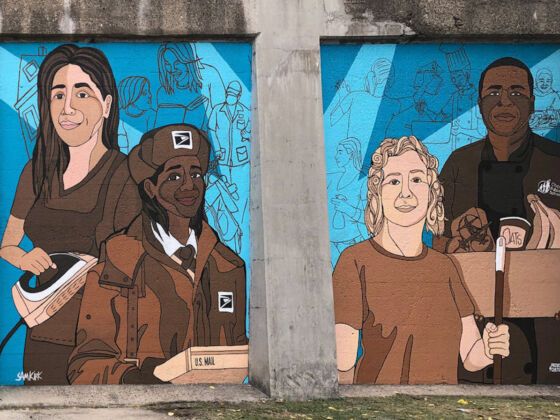

The World's Best Street Artists Who Use Their Art as Political Activism
This is the gap that street artists have traditionally filled: Their work is literally in public places, and the subject matter is traditionally — though not exclusively — selected with the layperson in mind. Eschewing the avant-garde, it is created to be interpreted by the average passerby. This notion of audience is exactly what can make street art so powerful and persuasive, and maybe, because of its populist nature, the perfect medium to apply a political bent.
While you may already have a couple of favorite street artists from your own community, a growing legitimacy surrounding the genre gives art appreciators throughout the world more access to work they may have otherwise not been able to engage with. World wide, more folks are applying their talents to informal, outdoor spaces in order to challenge the status quo, demand legitimacy for underserved communities, and create work that inspires a new generation of revolutionaries. If you’re looking to widen your knowledge of art as activism worldwide, here are a few artists with whom you can begin that journey.
1. Zéh Palito, São Paulo, Brazil,
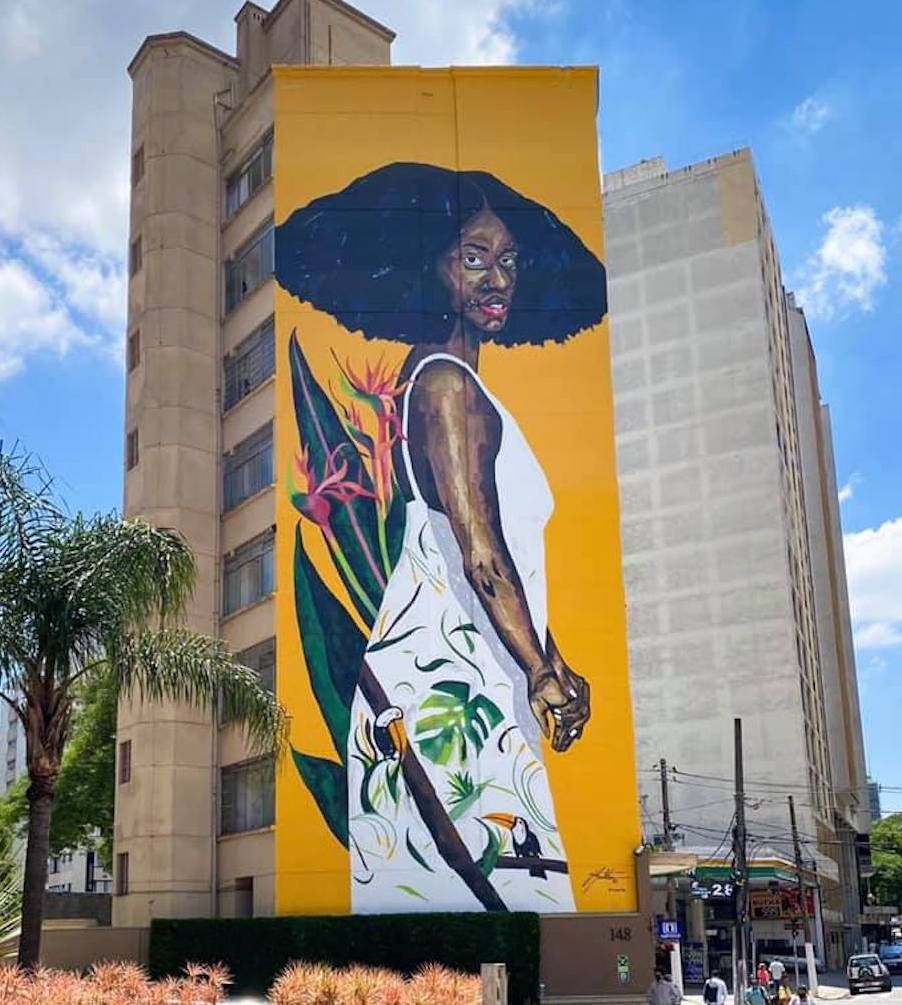
Photo: Zéh Palito/Facebook
Brazil is a country where Blackness, to put it excruciatingly simply, is complex. Though they never had a formal system of apartheid — like, for instance, Jim Crow in the United States, which segregated people by race — there has long been a social hierarchy that is demarcated by skin color. There are millions of people living in the country of African descent, but Brazillian culture would dictate further stratifications between them depending on the individuals’ ethnic makeup. Afro-Brazillian artist Zéh Palito seeks to unite Brazilians of African descent with his artistic practice by creating a visual cornerstone from which Black pride can pivot.
His work borrows items found in the natural landscape of Africa and unites them with the tropicalia Afro-Brasileiros find in their everyday lives. He removes his Black subjects from the mundane and places them in spaces that are simultaneously unmistakable yet removed from reality, largely with his fantastical choices in color palette. He applies paint energetically, either by stylus or spray can, and his unmistakable style of application, a hallmark of his work, saturates his subjects with an infectious energy.
One of his recent pieces in São Paulo marked a huge turning point in his career; this three-story high painting of Luciana Tavares marked the first time he was commissioned for a portrait on such a large scale. “Works like this with portraits of black or indigenous people are hardly approved,” said the artist of the work. “However, in this mural, I managed to faithfully reproduce the brushstrokes and feelings that I put on a canvas here on the wall.” This piece was made in collaboration with Museu de Arte de Rua for Black Awareness Day. The mural can be found at Rua Abílio Soares-17, Paraiso, São Paulo, Brazil.
2. Sophia Dawson, New York, US
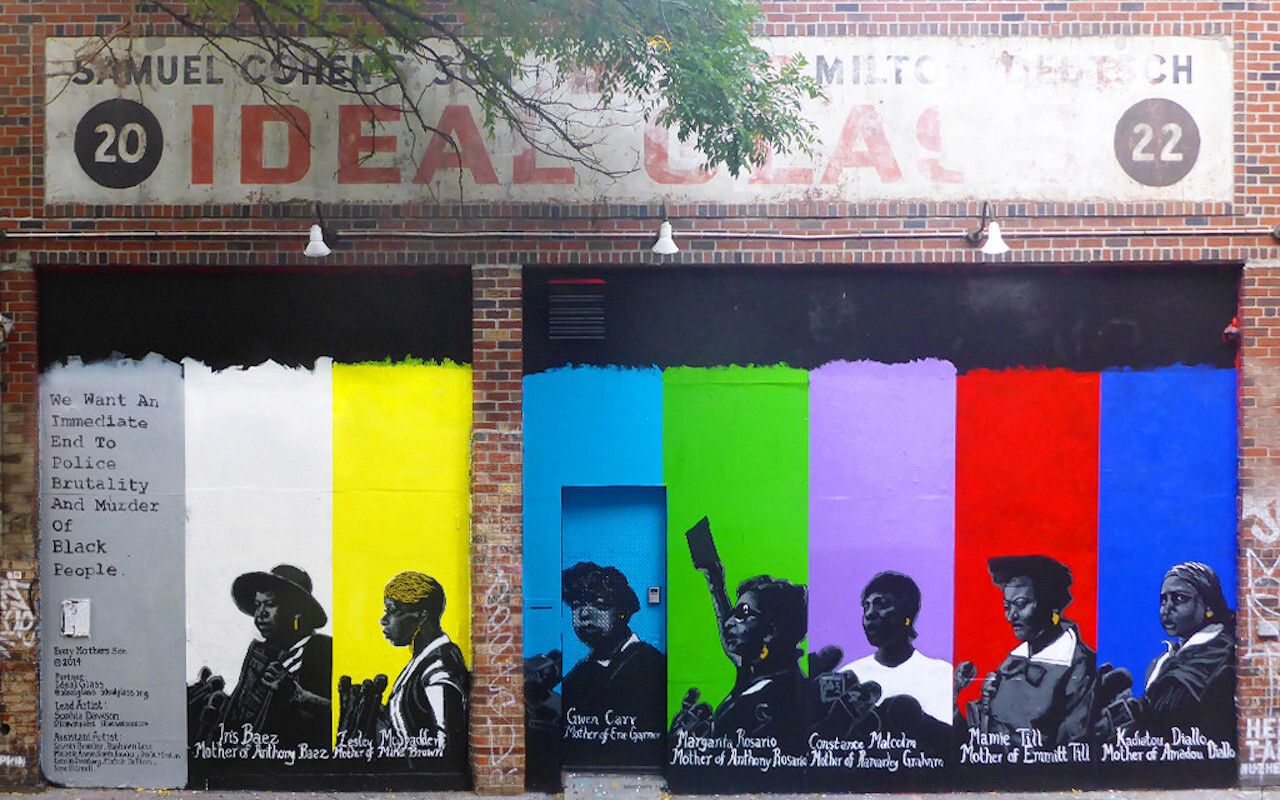
Photo: Sophia Dawson
I first met Sophia Dawson on the immaculately groomed lawn of the Confidante Hotel in Miami Beach back in 2018. “I like to work BIG,” she told me, gesticulating grandly from her repose in a luxuriously cushioned Adirondack chair, herself draped in a chic, colorful duster. She had just the day before completed a mural in Miami’s Wynwood District.
She’s spent her entire career creating work that exposes “the stories and experiences of individuals who are striving to overcome the injustices they face,” and she accomplishes this both with her subject matter and processes. Her work depicts folks affected by anti-Blackness. She paints the activists that have been incarcerated and the mothers left behind to remind us of the human toll of systemic racism. Her technique seeks to find multitudes in Black skin; Dawson’s skin tones are built layer by layer, swaths of colors draped atop each other, though an unmistakable Blackness is revealed at their nexus.
Over the summer she got the chance to apply her considerable skill to one of the many Black Lives Matter murals that sprang up on American streets beginning with the one in Washington DC. In this one, located in New York’s Foley Square, Dawson took charge of the word “Lives,” designing each letter differently. “The ‘L’ contains the faces of the mothers who have lost their children to police killings,” said journalist Julia Jacobs for the New York Times. “The ‘E’ contains faces of Black Panther Party members who are currently in prison, and the ‘S’ carries a passage from the Bible.” This mural can be found on Centre Street at Foley Square, New York, NY.
3. Osa Seven, Lagos, Nigeria
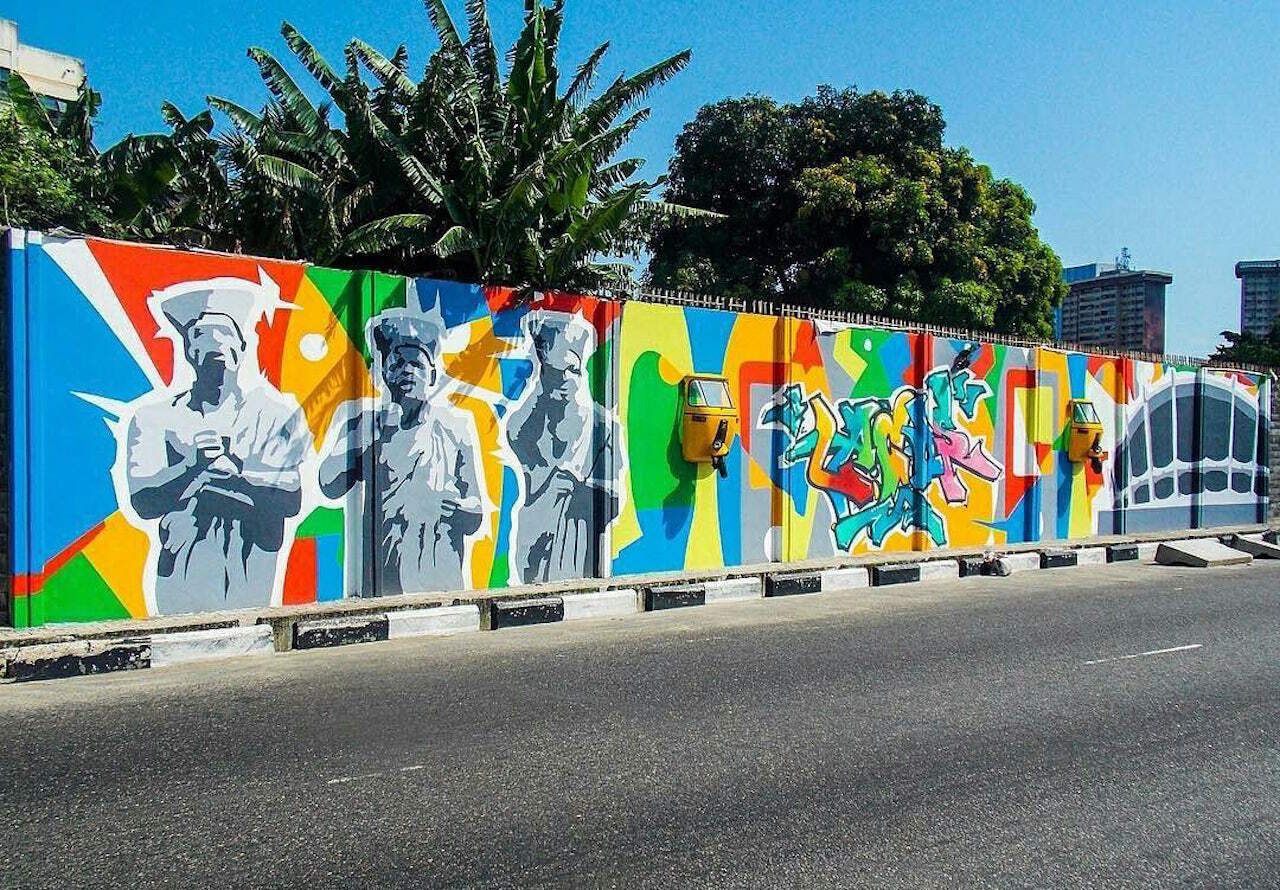
Photo: Oso Seven/Facebook
Osa Seven has been obsessed with art and design since he was a child. Though Lagos, from which he hails, didn’t have a tradition of professional graffiti artists when he began, he leveraged his knowledge of marketing and branding to create a thriving art business for himself in his native Nigeria. “I love graffiti,” says the artist, “like every other art form it has the ability to tell amazing stories.” Since he was a teenager, his goal has been to tell the stories of Lagos with public art, and he has not stopped since.
Because there are not the same traditions of graffiti in Lagos as exist in other countries, Osa had a certain freedom to invent his own style. Drawing from elements of western graffiti and adding pixelated effects common in graphic design, a field he has worked in, he has created a genesis of the two that now defines street art in Lagos.
In maybe his most ambitious project to date, in collaboration with the Ministry of Tourism, Arts, and Culture, he created a mural for the event Lagos @50. The mural is composed in three distinct sections separated by the disembodied front facades of two keke napep — or tuk-tuks. On the far right, it features the visage of the National Art Theatre, highlighting his skill at producing a computer-generated-esque style.
The far left features a stylized image of Bodun Shodeinde’s Aro Meta installation, the famous Welcome to Lagos sculpture aside the Lagos-Ibadan expressway. In the middle, in classic graffiti, is the simple message “Lagos,” which reminds the viewer that the stories of Nigeria are free to be interpreted by a new school of creatives. You can find this mural at the Law School bus stop on Ozumba Mbadiwe Road, Victoria Island, Lagos, Nigeria.
4. Hamza Abu Ayyash, Ramallah, Palestine
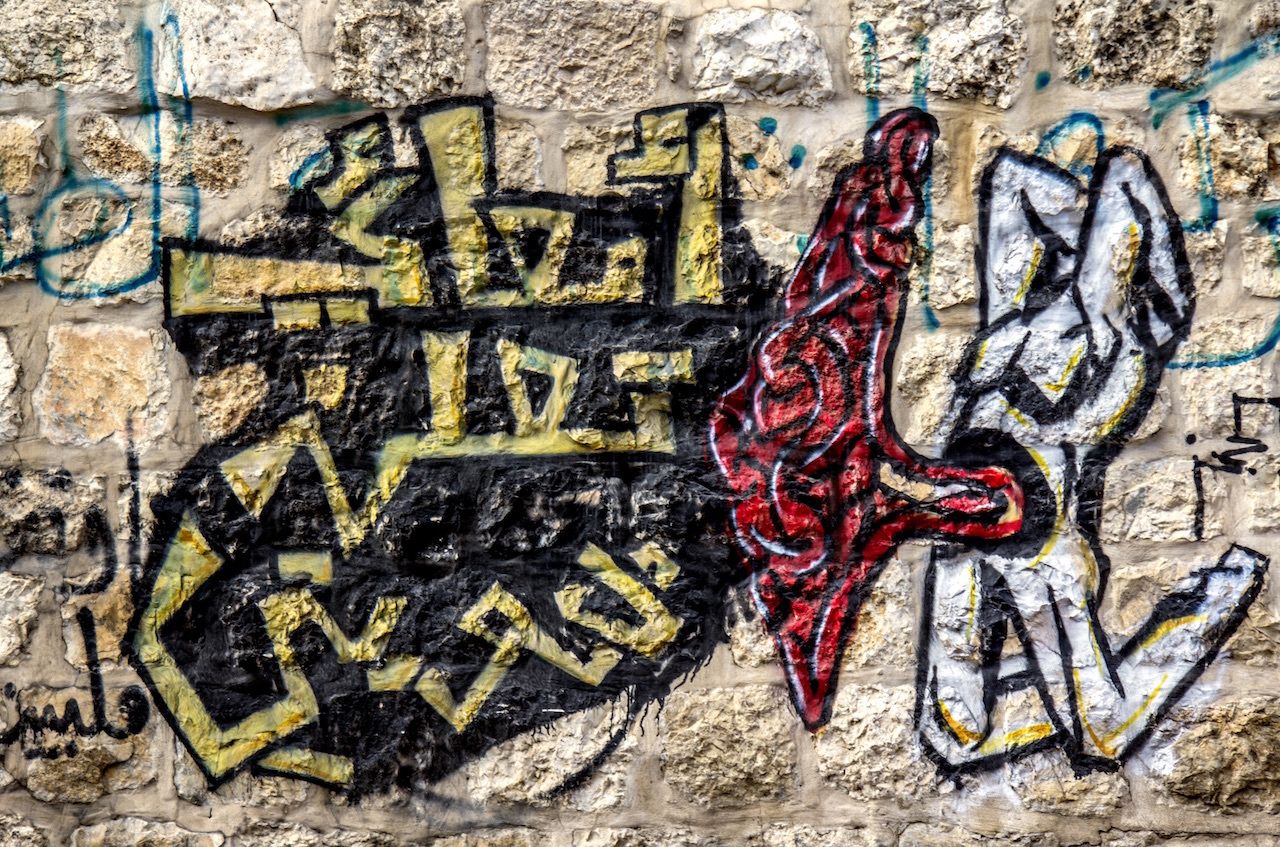
Photo: Philip Rahnhopper
The Israeli West Bank barrier, the illegal wall that separates Israel from Palestine along the green line, has different names depending on who you ask. Its Hebrew name translates to “separation fence” while its name in Arabic, the language spoken by Palestinians, calls it “the wall of apartheid.” Though intended to be temporary, construction began on the wall in 2002 and still stands today even though it was deemed a violation by the International Court of Justice.
While the Israeli side of the wall is largely free from decor, the Palestinian side has been transformed into an ever-fluctuating outdoor gallery of pro-Palestine street art. While international artists, such as Banksy, have been known to contribute with a series of very controversial paintings, it is the domestic artists that serve to preserve the culture of Palestine and promote the universally welcomed message that the wall should come down. Among these Palestinian artists who have made the wall their canvas is Hamza Abu Ayyash who uses a mix of Arabic calligraffiti and simple, graphic organic illustrations highlighting the struggles of the Palestinian people.
Probably his most famous body of work was his hunger strike graffiti project in 2012. Inspired by the detention of Khader Adnan — who was arrested under an indefinite detention scheme sanctioned by Israel — Ayyash produced a number of works both on the barrier wall and elsewhere in the West Bank. Each piece contains a snippet of provocative text in his distinct calligraffiti style. One particularly arresting work features a disemboweled figure, the exposed intestines rendered to resemble a mushroom cloud. The adjacent text, a quote from Nayef Bazzar — a Palestinian who spent six years imprisoned in Israel — reads, “my guts declares my identity.” This mural can be found across the street from the parking lot for Bethlehem University, Palestine, though part of it was whitewashed in 2014.
5. Alaa Satir, Khartoum, Sudan
Beginning in 2018, the Sudanese revolution, which included months of protests, led to the removal of the long-ruling dictator, Omar al-Bashir in April of 2019, followed by a bloody transition of power. Though the timeline for the solidification of the Sudanese government is still ongoing, it will ideally lead to an equitable, stable civilian government by 2021. Within this landscape, several street artists emerged — among them Alaa Satir, whose work reminds us that within the predominantly male-led military actions, much of the work on behalf of civilians was planned and executed by women who were organizing within the communities of Sudan.
Though Satir is formally trained as an architect, she currently produces as a graphic designer, illustrator, and muralist. Satir’s work is almost whimsical but incredibly direct; her bold illustrations coupled with unambiguous text make it clear what she believes her responsibilities to her nation are. Her paintings of women — often in a stance of defiance and bearing a crown that floats like a halo — not only serve to document the women that she saw around her fighting for freedom but also inspire a new generation of girls who will learn resistance as a lifestyle.
One piece that so encapsulates her political stance is painted on a residential wall, of a festooned woman with her fist rebelliously thrust into the air. “A woman’s place is in the resistance” is printed in Arabic surrounding her. Satir said in an interview that, “it perfectly describes how we were fighting two systems at once. It was a fight that started way before the recent political uprising where we just struggled on a daily basis to be heard and included in a society that has very limited roles for us.” This mural can be found in Burri, Khartoum, Sudan.
6. Sam Kirk, Chicago, USA
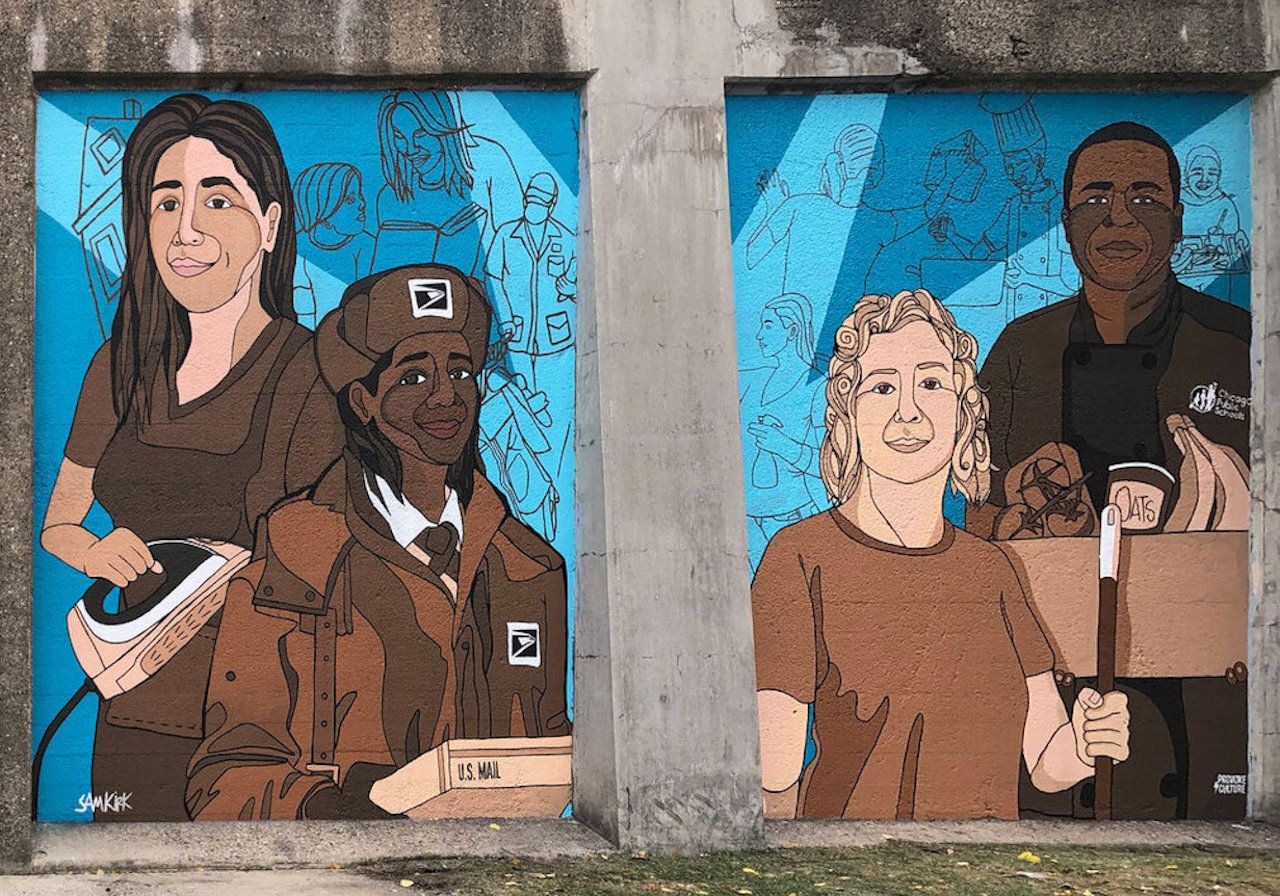
Photo: Sam Kirk
Born and raised in Chicago’s South Side, Sam Kirk has been known to remark that she finds it remarkable to be living her life as a working artist. Her career began as a hobby, but in her early adulthood when she was working in her then chosen career of advertising, she began to feel the needs of her community pressing her to pursue a different path. “I started to get involved in mural work mostly because I felt like there were issues that needed to be addressed and I thought public art was a great way to start that conversation,” she told Windy City LIVE in 2019.
Kirk imbues her work with the stories and faces from the working-class neighborhoods that helped shape her. Rather than mere depictions of the multicultural people that surround her, she creates work that demands recognition for a group of people that she does not deem herself disparate from. Her work is colorful and graphic, as vibrant as the people she’s painting, and her color choices are reminiscent of the tradition of painted signs in South Chicago.
Recently, Kirk used her substantial skill in tribute to essential workers during the COVID-19 pandemic. Though only four Chicago residents lent their visage to the piece — Carilla Hayden, a USPS postal worker; Juan Burrell, a Chavez Elementary school lunchroom manager; Veronica Sanchez, a leader of the Latino Union of Chicago and nanny, and Maggie Zylinska, a domestic worker — it is meant to represent the admiration and thanks she has for all the essential workers who risked their lives to keep our communities afloat in 2020. This mural can be found in the B Line Art Corridor, Hubbard Street at Milwaukee Avenue, Chicago, Illinois.
7. Chief Lady Bird, Toronto, Canada
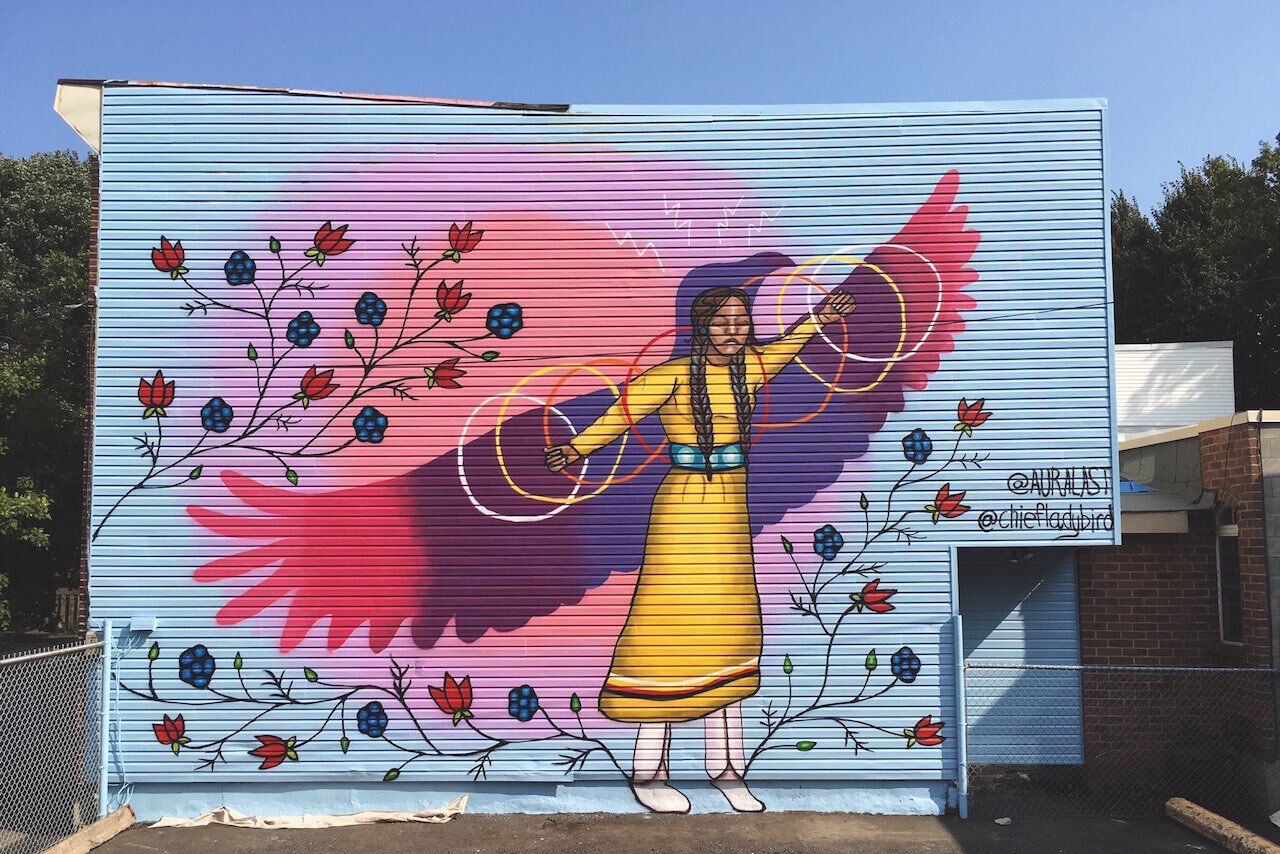
Photo: Chief Lady Bird
In a report leaked in 2019, the number of murdered and missing Indigenous women (MMIW) over the past 30 years in Canada was so steep that it has been characterized as the “Canadian Genocide.” While all members of Indigenous communities are subject to the perils of systemic racism, women and girls are particularly vulnerable. Indigenous women in Canada are over three times more likely to experience violence than their non-Indigenous counterparts. But an often unseen consequence of the staggering rates of gender-based violence against these communities of womxn is the way it creates the stereotype that they should remain sexually puerile, removed from owning or expressing sexuality in any way lest it “attract” violence against them.
Chief Lady Bird, herself of Chippewa and Potawatomi descent, uses her artistic practice to subvert these stereotypes. She grew up on a reserve but now lives in Toronto where she works as a muralist and illustrator. “One [issue] that I think needs to be addressed is the perception that Indigenous womxn can’t or shouldn’t make work about sex and sexuality because it puts us further at risk,” she told Flare in 2018. In her work lives the experiences and struggles of Indigenous womxn, including the expression and ownership of sexuality.
In 2017 as a part of Unceded Voices, a convergence of anti-colonial artists in Montréal, Chief Lady Bird partnered with fellow Toronto artist Aura Last to create Hoopdancer, a public work depicting an Indigenous woman transfixed in dance in their typical bright, holographic color palette. The artists collaborate on murals and other works so frequently that their styles have evolved together, creating their own school of two. This mural can be found at 393 Rue Saint-Ferdinand, Montreal, Canada.
8. Libre, Mexico City, Mexico
I met Libre on the quaint, central DF pedestrian street called Regina, where he was painting a mural adjacent to a basketball court with some kids in the community. At that time, back in 2013, Libre was still living on the northwest coast where he’s from, in Tijuana. He made a name for himself there with his work exploring the validity and the influence of La Frontera: the colloquial name for the US/Mexico border. This thread continues today, though he has branched out as far as medium. In addition to his large-scale murals, maybe his most exemplary works are his recycled wood and metal sculptures.
Maybe most notably of the latter work is his guerrilla sculpture, :La Transportapueblos,” a nearly four-meter tall coyote, the animal was so chosen because it lends its name to the Mexican fixers who smuggle Central American migrants through Mexico. The piece is located in Tapachula, Mexico, where many board and disembark from La Bestia — a northbound cargo train on which migrants stow away to reach the United States.
Adorning the massive coyote is a guide for travelers who encounter it: a map of Mexico on one side displays routes migrants can take to mitigate danger, the other a list of safe houses, replete with phone numbers and addresses. Unlike the human coyotes paid to usher people north, Libre’s coyote intends to take nothing from its visitors, it even houses a space on its tail for supplies such as medicine, food, and water. Installed in 2019, it is intended to be one in a series of many. It is hoped that the project will eventually span the length of the country from Tapachula to La Frontera itself. This sculpture can be found at Calle Decimosecta Pte. 10, Los Naranjos, San Sebastian 30790, Tapachula de Córdova y Ordoñez, Chiapas, Mexico.